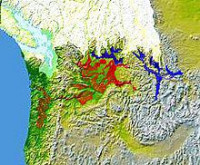|
The view is of the massive potholes caused during the Missoula floods. Stop 9 in Baker et al.
"The drainage divide into Potholes Coulee (365 m) is the lowest of the three cataracts that cascaded from the Quincy Basin into the Columbia valley. This spectacular feature deservedly caught the attention of previous investigators (Baker and Nummedal, 1978; Edgett et al., 1995; Bjornstad, 2006a) and especially Bretz (1923, 1925, 1928, 1930b, 1959; Bretz et al., 1956), who referred to this feature as Potholes cataract. Potholes Coulee (Fig. 30), like neighboring Crater Coulee and Frenchman Coulee, formed spectacular, horseshoe-shaped, multi-tiered cataract canyons when floodwaters quickly rose up to 442 m elevation, overtopping several divides across Evergreen and Babcock ridges. When this happened, a drop of >260 m was created over a distance of less than 5 km between the Quincy Basin and the Columbia River Valley to the west. With this difference in water level over such a short distance, floodwaters furiously ate away at the underlying basalt layers. Topsoil was completely stripped away, along with hundreds of meters of bedrock, carving deep chasms into the ridgeline (Fig. 30)."

The Missoula Floods (also known as the Spokane Floods or the Bretz Floods) refer to the cataclysmic floods that swept periodically across eastern Washington and down the Columbia River Gorge at the end of the last ice age. The glacial flood events have been researched since the 1920s. These glacial lake outburst floods were the result of periodic sudden ruptures of the ice dam on the Clark Fork River that created Glacial Lake Missoula. After each ice dam rupture, the waters of the lake would rush down the Clark Fork and the Columbia River, flooding much of eastern Washington and the Willamette Valley in western Oregon. After the rupture, the ice would reform, creating Glacial Lake Missoula again.






 Please share your ideas with us.
Please share your ideas with us.